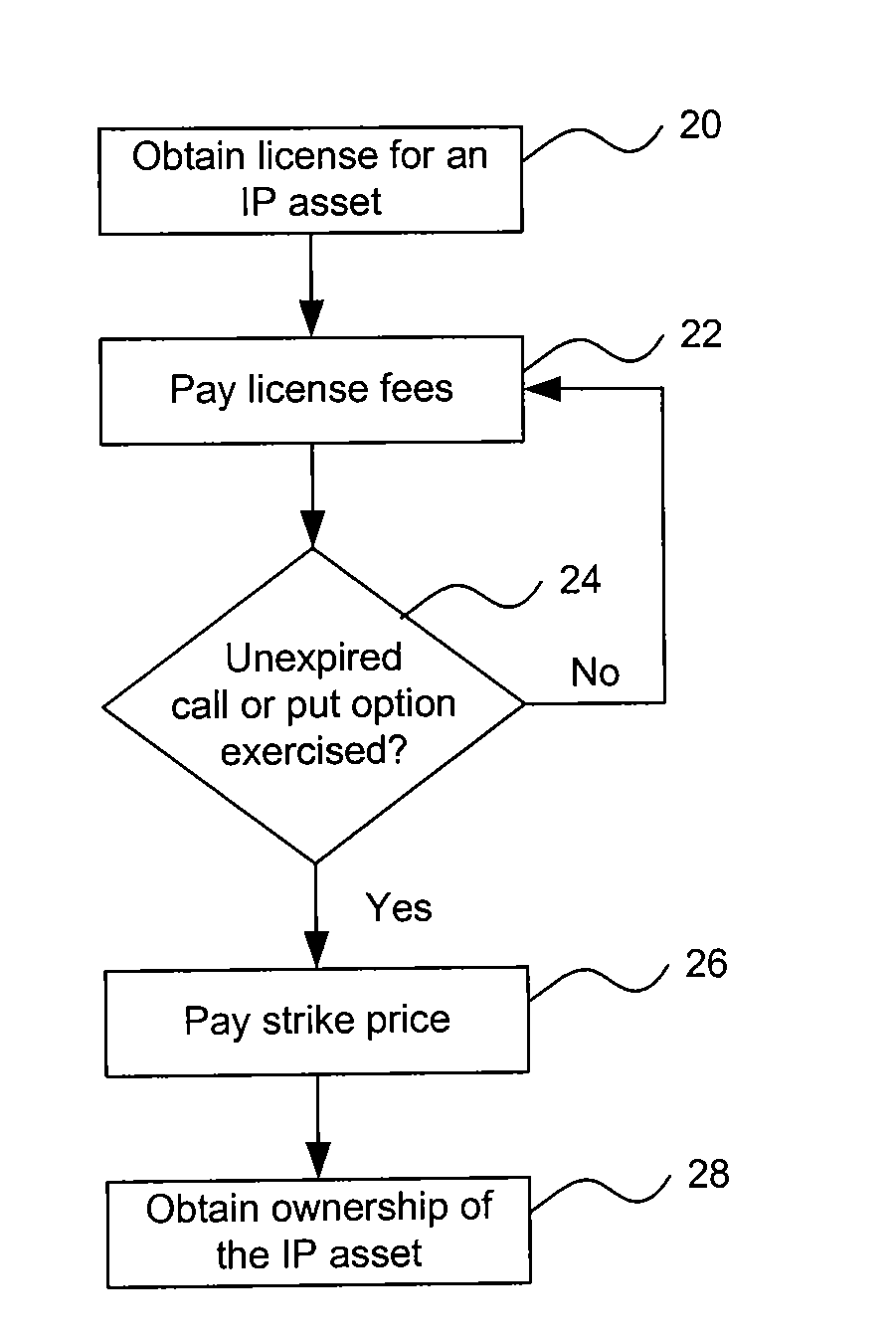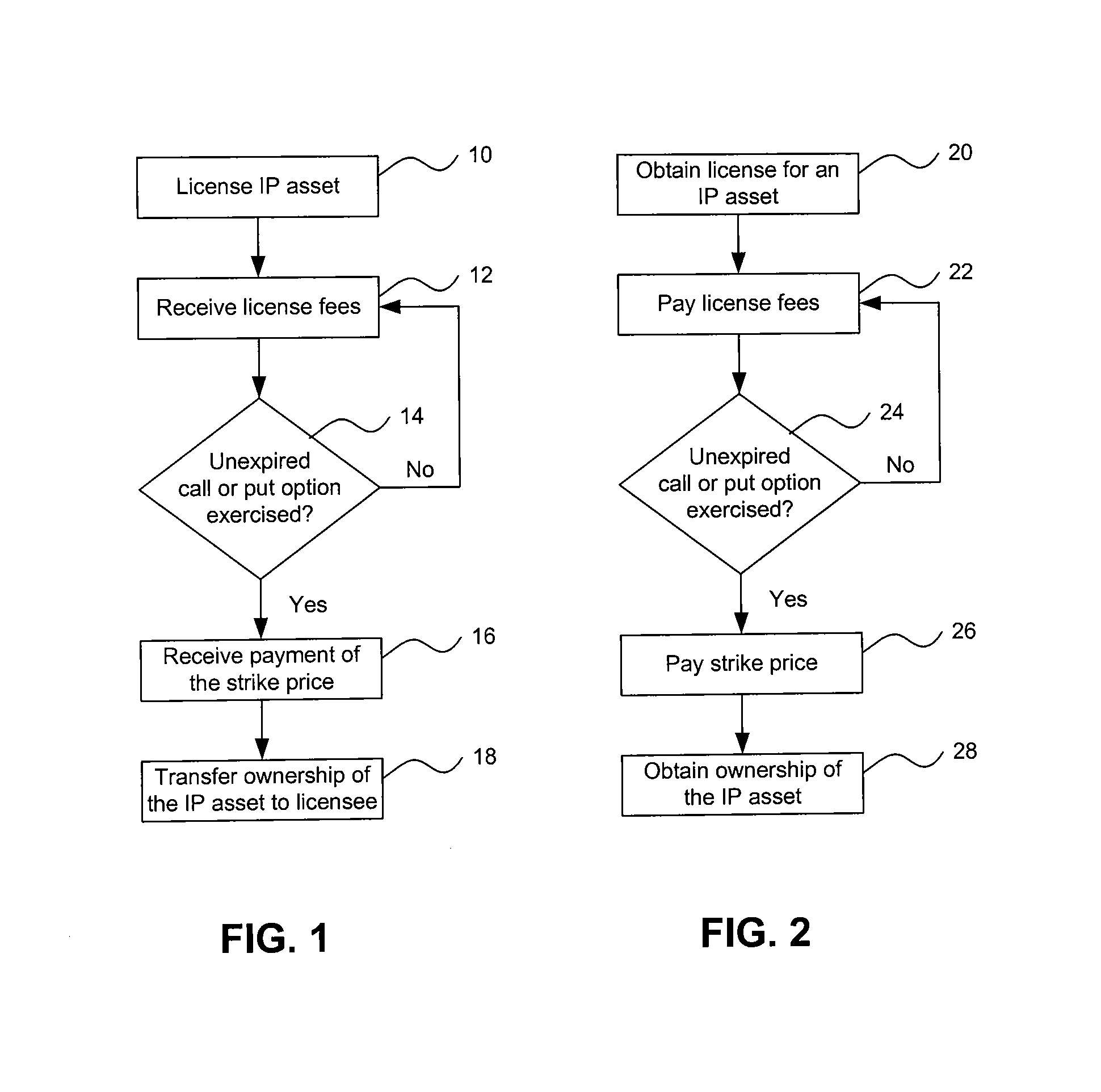Methods For Intellectual Property Transactions
a technology of intellectual property and transaction method, applied in the field of intellectual property transactions, can solve the problems of exacerbated dilemma of successfully pricing early-stage ip, increase the risk of payment default, so as to reduce the risk and uncertainty associated, discourage the effort of licensee design-around, and reduce the risk of default
- Summary
- Abstract
- Description
- Claims
- Application Information
AI Technical Summary
Benefits of technology
Problems solved by technology
Method used
Image
Examples
example 1
[0029]Assume a patent license agreement with a 10% running royalty on sales of products incorporating the subject technology and a 10 year call option with a strike price of $5 million. Under such a scenario, the licensee would pay a 10% royalty on sales but would have the option to purchase the patent outright for $5 million at any time over the next 10 years. The financial payoffs of structuring an agreement in such a way are similar to those achieved by the inclusion of a maximum royalty provision, in that the licensee may exercise the call option and pay $5 million to then be absolved from any further royalty obligations. However, unlike a license with a maximum royalty provision, the execution of a call option would convey the right of patent ownership to the licensee. As a result, the use of a call option would likely provide a greater incentive to the licensee to invest in and commercialize the technology in that the agreement would provide, at the option of the licensee, all...
example 2
[0030]Assume a patent license agreement with a 5% running royalty on sales of products incorporating the subject technology and a 10 year put option with a strike price of $5 million. The financial payoffs of structuring an agreement in such a way are similar to those achieved by the inclusion of a guaranteed minimum royalty provision, in that the licensor may receive at least $5 million under the agreement should the licensor choose to exercise the put option. However, unlike a guaranteed minimum royalty provision, the use of a put option allows for the patent holder to “wash his hands” of the technology by forcing a sale to the licensee. In such an event the licensor would no longer be responsible for the management of the portfolio, payment of maintenance fees, or any other activity required maintain the technology for the purpose of complying with the terms of the license agreement. Furthermore, because structuring the agreement in such a way would both guarantee the licensor a ...
example 3
[0031]A license agreement is structured by identifying an IP asset, a license fee for an IP right corresponding to the IP asset (e.g., a patent), a strike price at which ownership of the IP asset may be transferred and an expiration date prior to which ownership may be transferred (i.e., either purchased or sold) at the strike price. A call option and / or a put option with the identified strike price and expiration date are included in the license agreement, and the license agreement is then offered for execution. The call option provision provides a licensee a right to purchase ownership of the IP asset at the strike price within a specified time period prior to the expiration date. The put option provision provides an IP owner / licensor a right to sell ownership of the IP asset at the strike price within a specified time period prior to the expiration date.
[0032]Additional IP assets may be identified, and license fees for rights under the additional IP assets, along with call or put...
PUM
 Login to View More
Login to View More Abstract
Description
Claims
Application Information
 Login to View More
Login to View More - R&D
- Intellectual Property
- Life Sciences
- Materials
- Tech Scout
- Unparalleled Data Quality
- Higher Quality Content
- 60% Fewer Hallucinations
Browse by: Latest US Patents, China's latest patents, Technical Efficacy Thesaurus, Application Domain, Technology Topic, Popular Technical Reports.
© 2025 PatSnap. All rights reserved.Legal|Privacy policy|Modern Slavery Act Transparency Statement|Sitemap|About US| Contact US: help@patsnap.com


